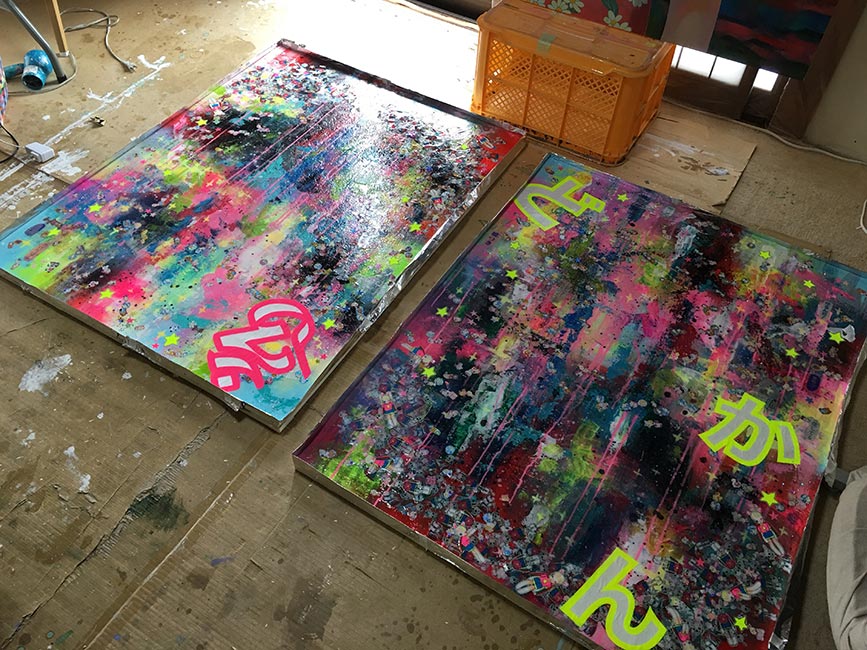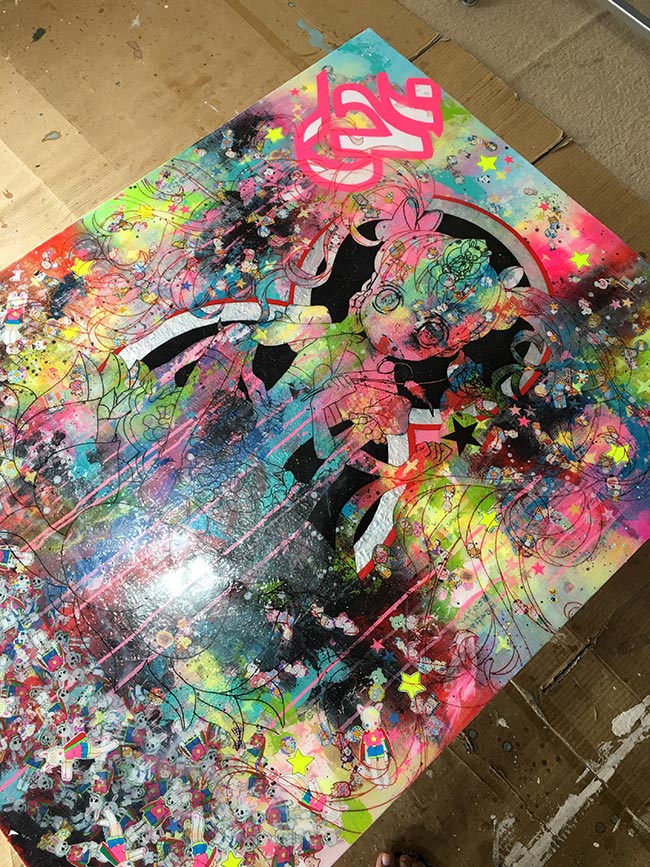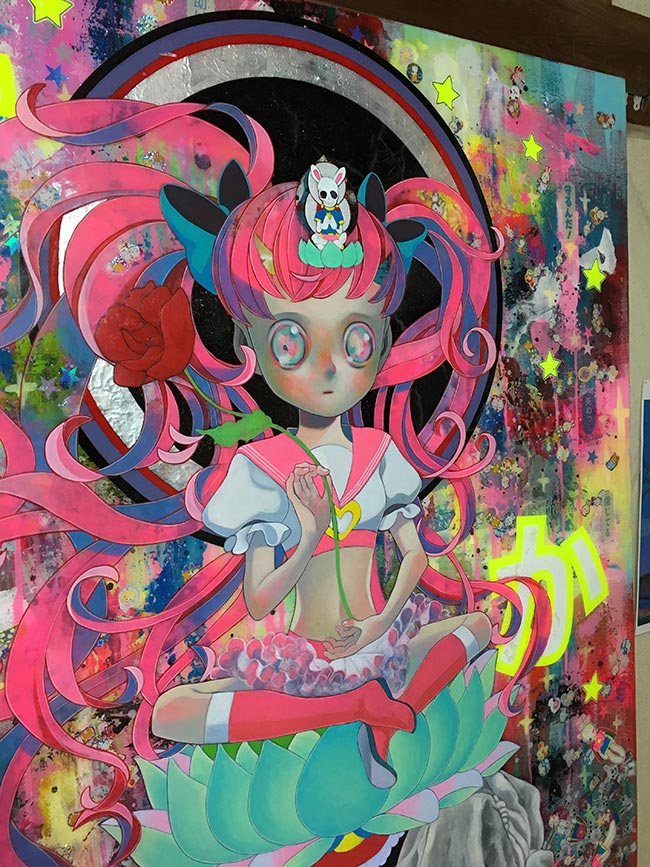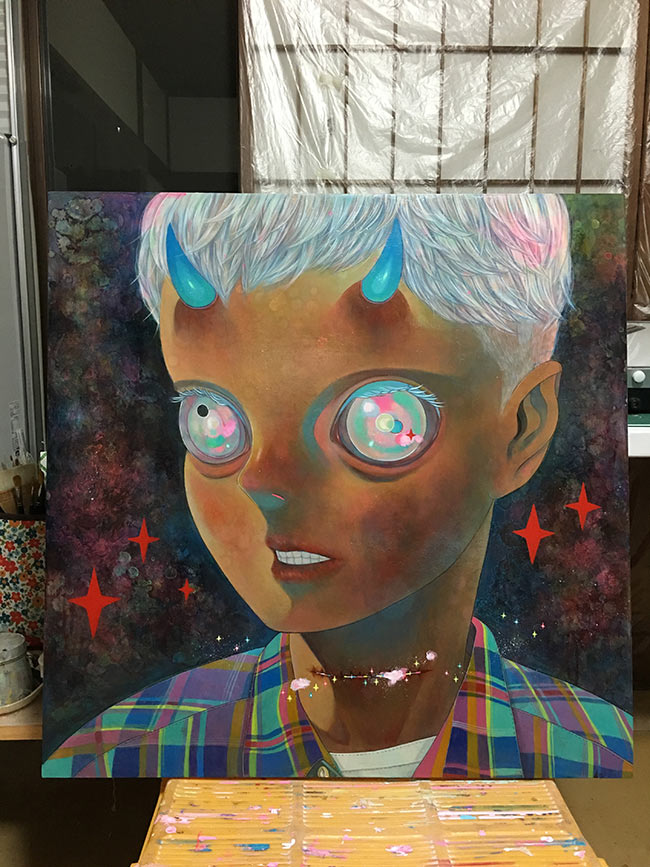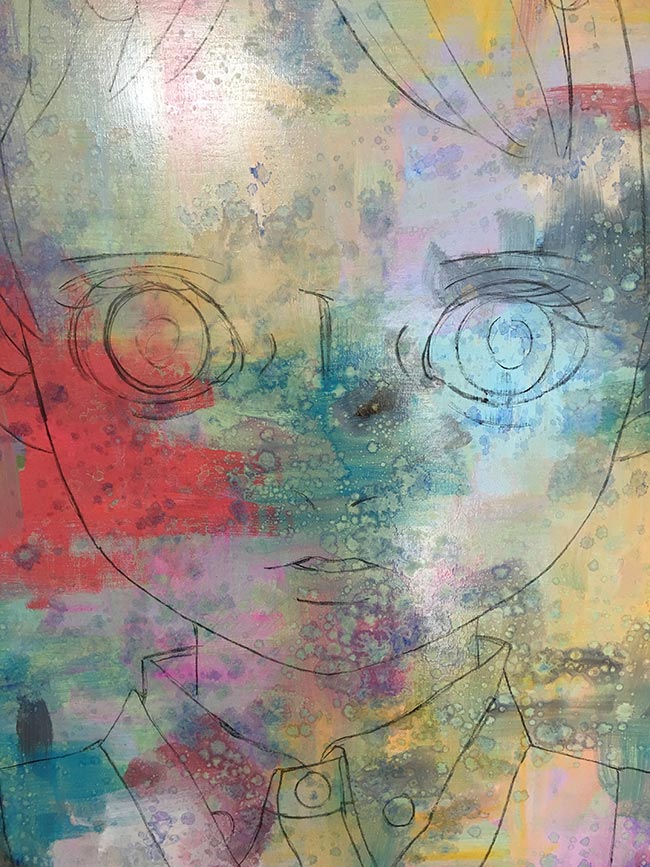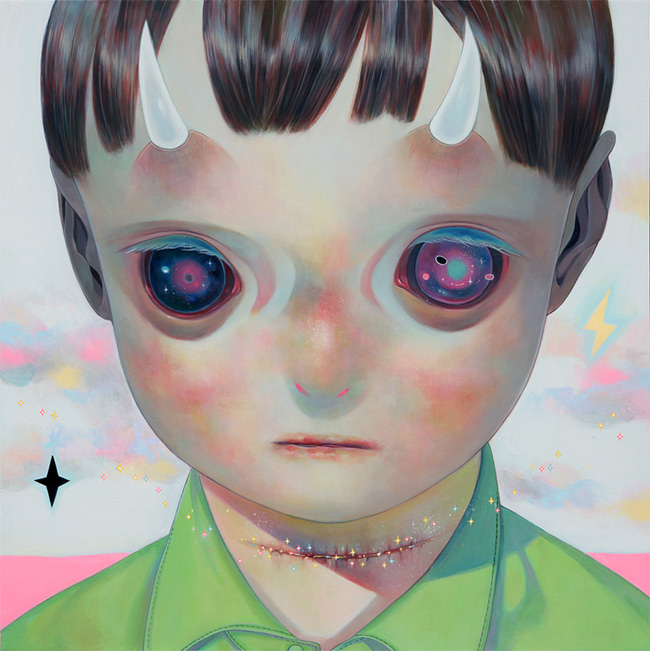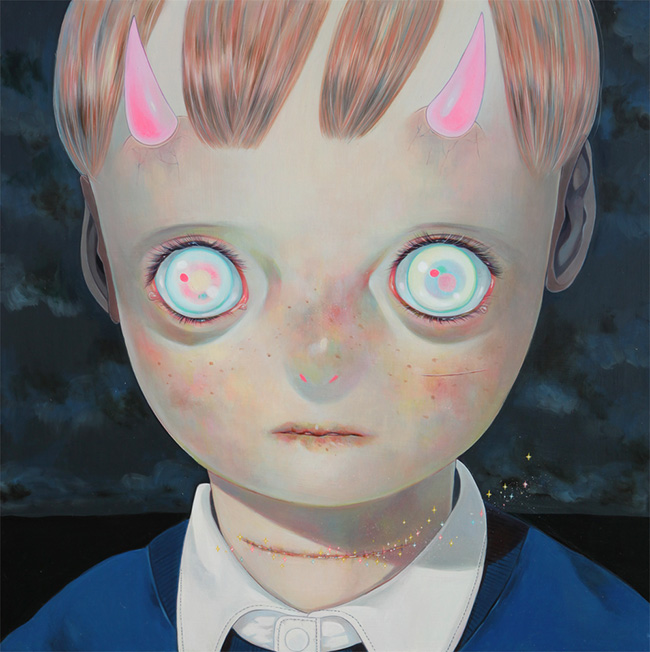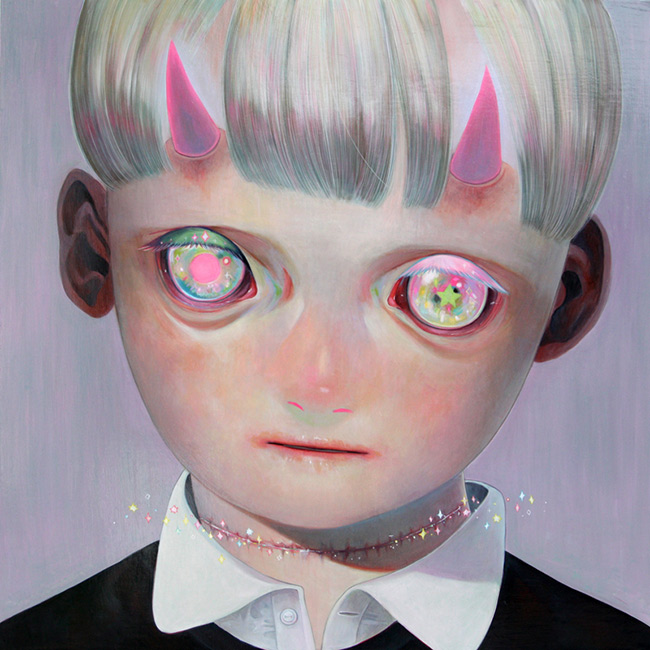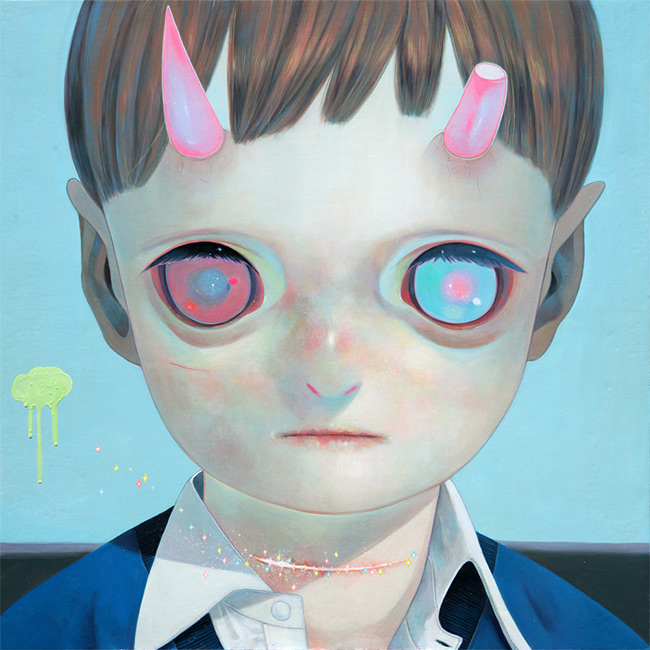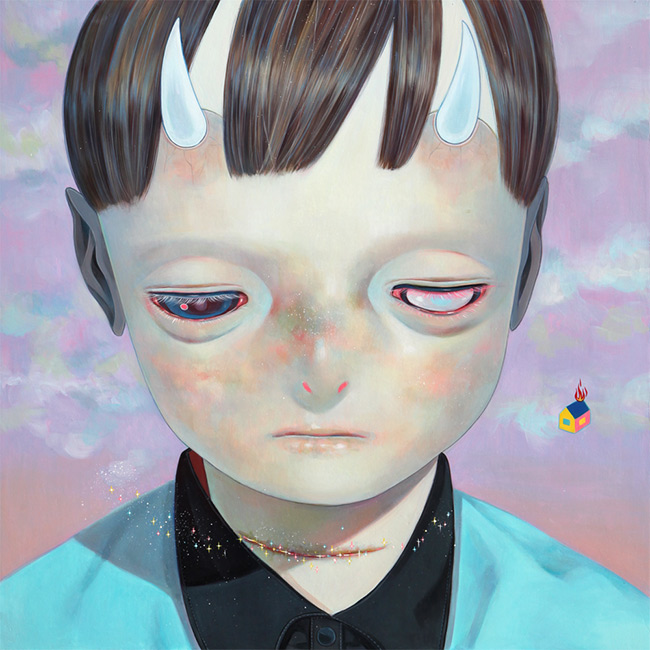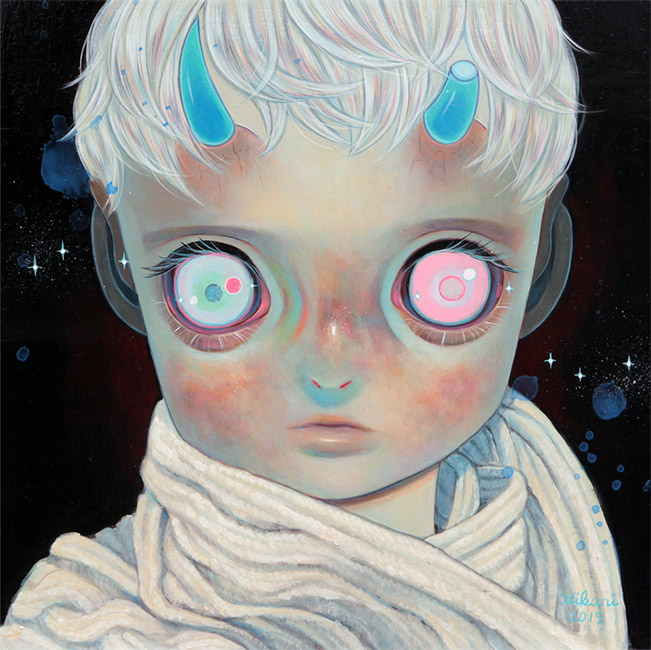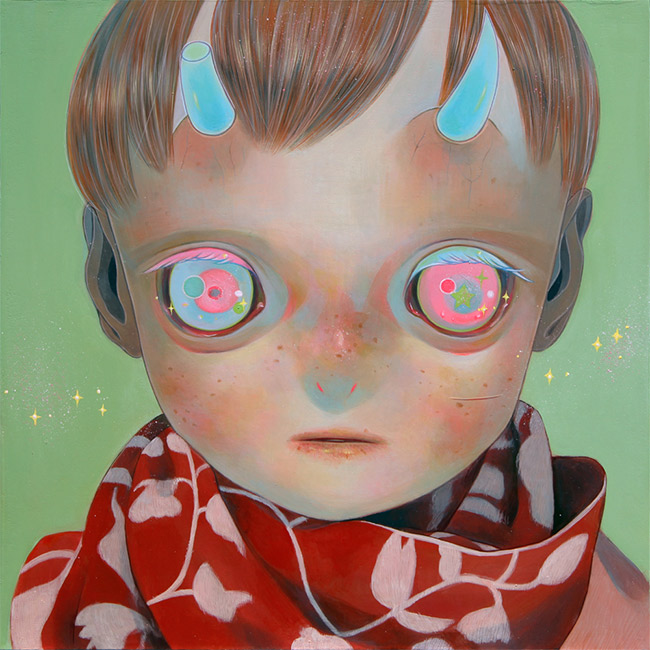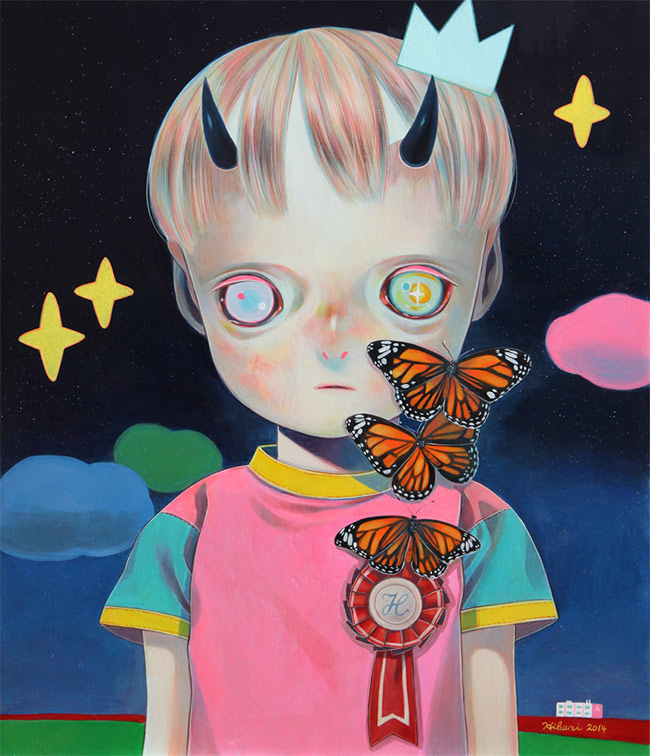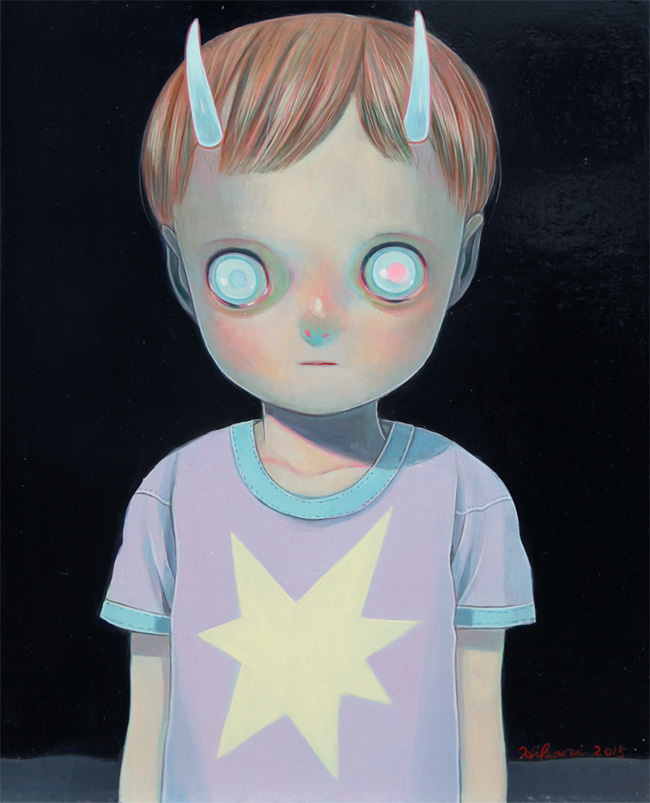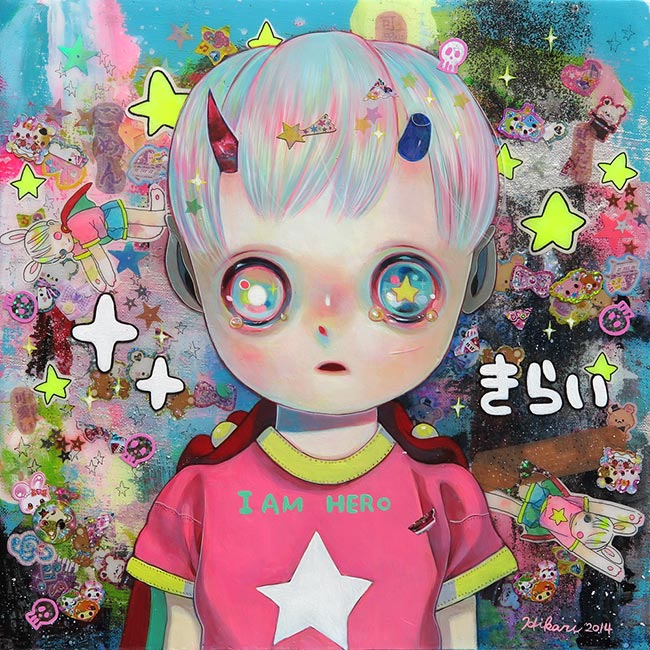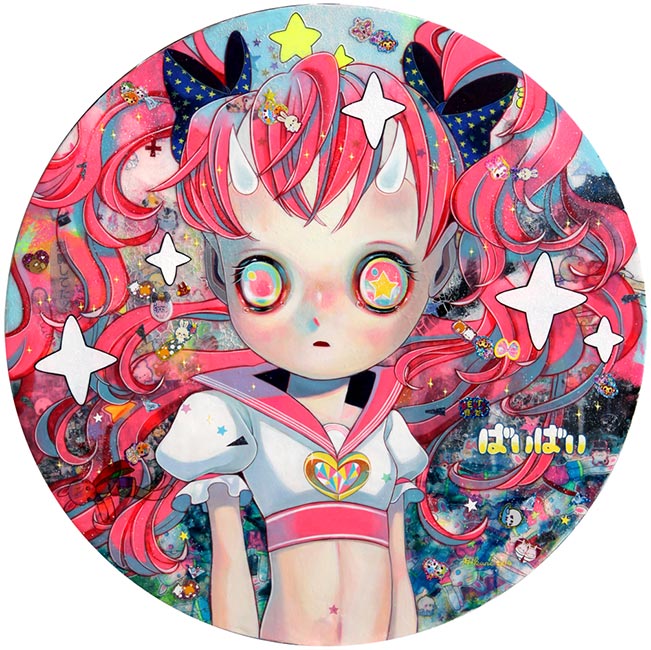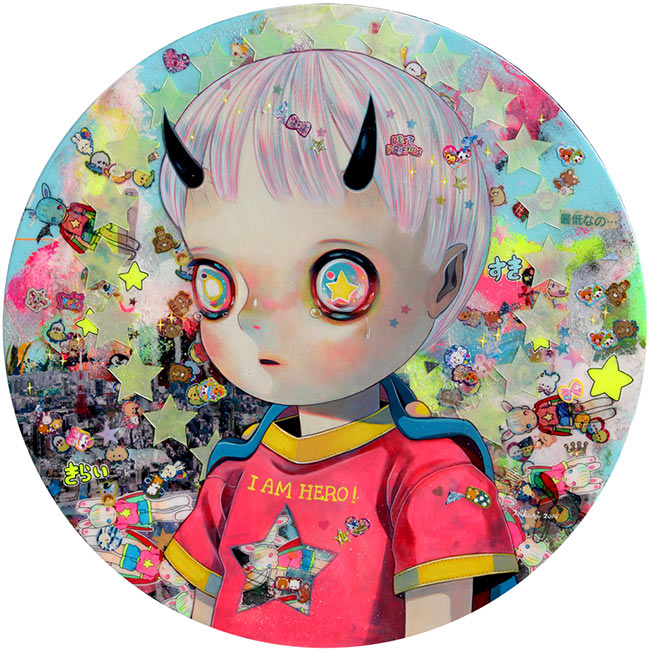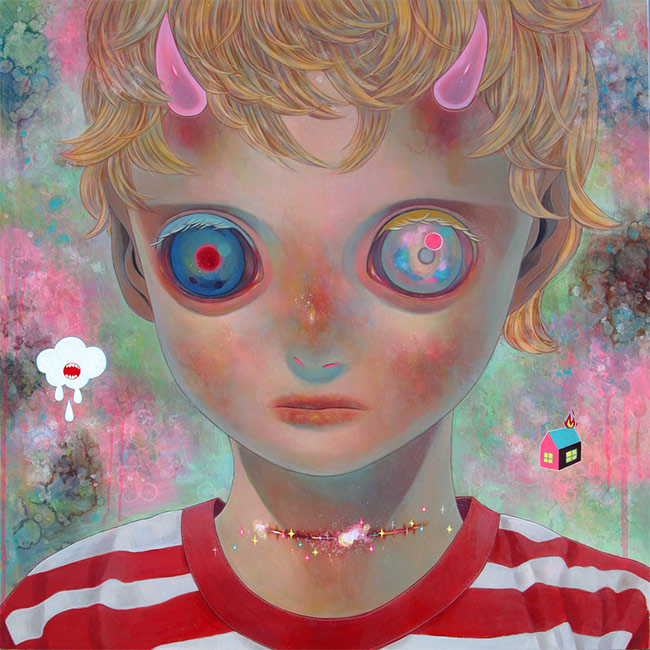The paintings of Hikari Shimoda beguile with their sparkling magic and seduce us into a fantastical world where everything is not quite as it first seems. The kawaii and manga inspired cuteness soon reveals itself as a clever, candy coated mechanism to gain our attentions before unveiling Shimoda’s deeper, darker and ultimately more concerning commentary on the human condition and the general well being of our world, or lack thereof. The starry-eyed children at the center of her imagery present themselves as symbolic vessels of hope and relief; saviours, very similar to religious deities or the extraordinary superheroes from popular culture, who never fail to capture our imaginations, or save the day. Through these youthful protagonists we follow thought provoking narrative threads which have us questioning vital aspects of our own adult characters and how they contribute to the proliferation or prevention of the wrongdoings and failures so abundant within our contemporary society.
Hikari Shimoda was born in 1984 in the Nagano Prefecture of Japan, where she still lives to this day. In 2005, Hikari earned her AFA in illustration from Kyoto Saga University of Arts in Kyoto, Japan. She started her painting career in 2008 and soon after earned her first solo exhibition at Motto Gallery in Tokyo. Since then she has built up an impressive international following and has exhibited her work in prestigious galleries throughout the world.
WOW x WOW recently caught up with Hikari as she was putting the finishing touches to a brand new body of work for her upcoming show at Corey Helford Gallery. The show is entitled ‘Memento Mori’ and Hikari sheds some light on it’s themes and inspirations in the following exclusive interview.
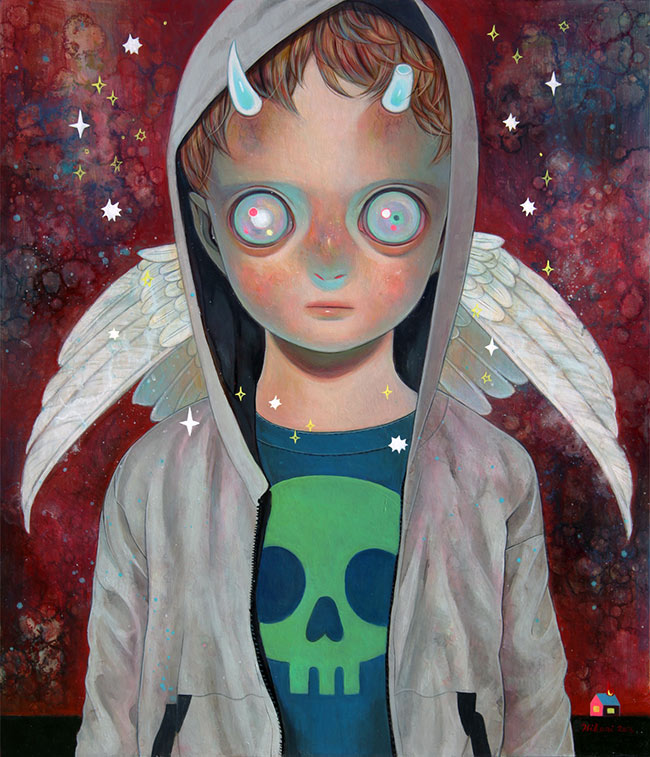
Hi Hikari! First of all, thanks for agreeing to free up some of your valuable time in order to have this wee chat, we really appreciate it. If you could please start us off by introducing yourself and talking about your background, touching on anything you feel has been relevant to shaping Hikari Shimoda the artist?
I was born in 1984, and raised in the Nagano Prefecture of Japan. I’ve always liked to draw pictures since I was young, and my friends also liked drawing pictures. I liked animation and manga and dreamt about becoming a manga artist one day, but in high school, I was introduced to painting and eventually decided to become a painter.
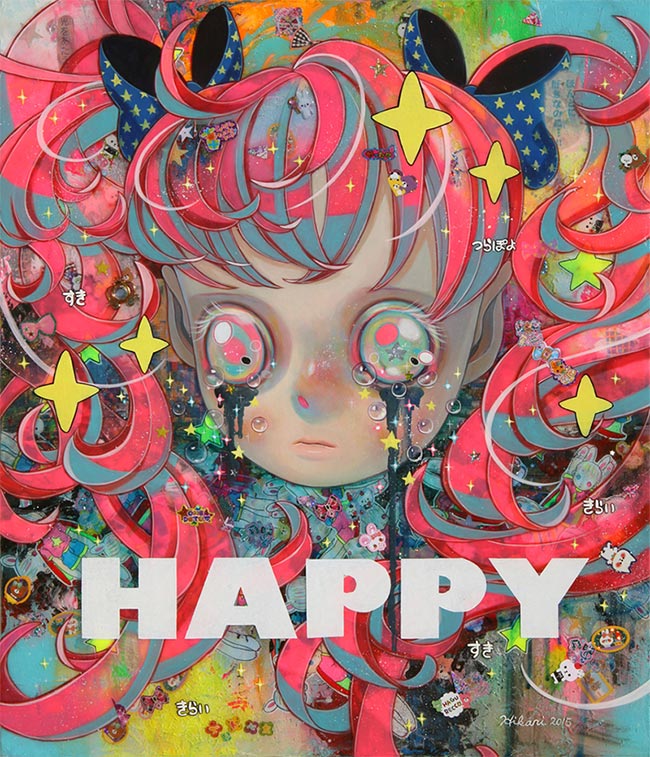
We’re interested to hear about where you’re currently living and your likes and dislikes about the area?
I still live in Nagano, the place where I was born and raised. It’s a place where there is nature everywhere, with wide open fields and surrounding mountains nearby. Though I have beautiful scenery where I can concentrate on my work, nature is not really my main inspiration, as I grew up with it and feel overly familiar with it.
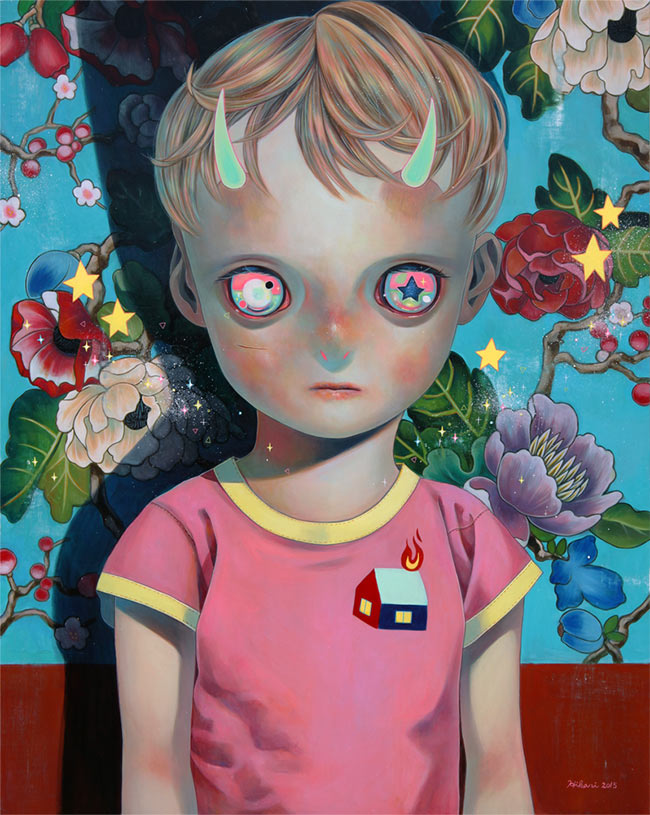
In what ways did your childhood and upbringing affect your relationship with the arts?
My parents were interested in art, so we would often visit art museums. My mother was a nursery school teacher, and she provided me with a lot of picture books at home; I think this was my first introduction to art and painting.
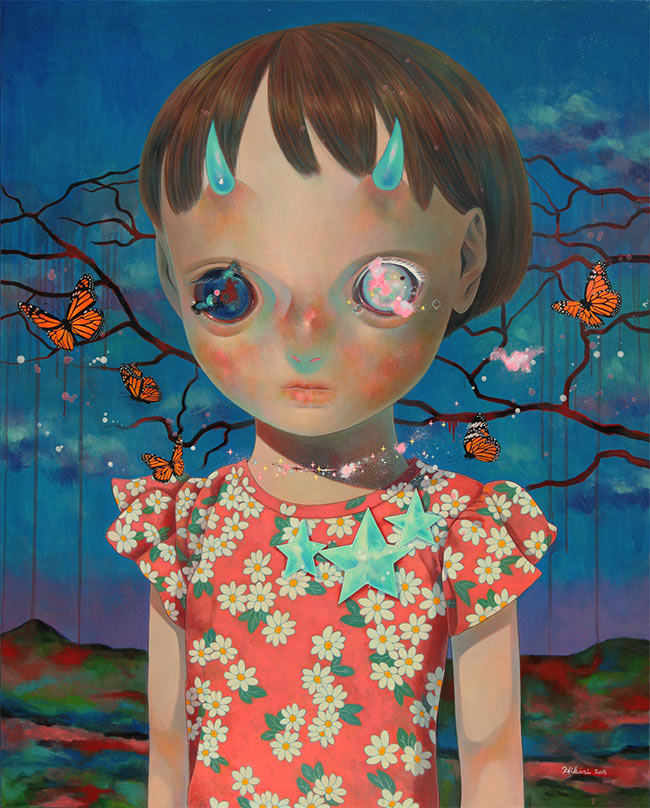
You’re currently working towards a solo exhibit at Corey Helford Gallery. What can you tell us about your latest body of work? What themes have you been enjoying exploring in your latest series?
In this solo exhibit, my main theme is ‘death and relief’. I imagine the modern world as a netherworld about to burst with its many problems, and humanity is struggling to cope with its imminent demise. Religion offers us a savior; in my work, I depict god like characters who offer us relief. As human beings, we attack each other, make enemies, and so I surround them with angels of death. Also, there are children of various races in my new paintings. I wanted to draw upon a theme that was not specific to any race or country, but a theme that relates to the whole world. So, I call those portraits the ‘Nobody’ series.
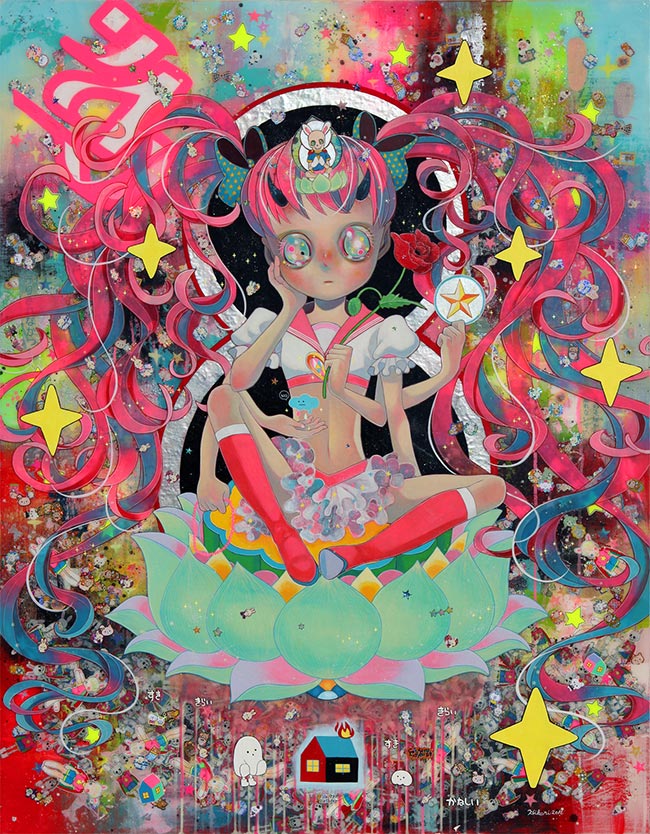
Storytelling and narrative are at the heart of your creative process. In your opinion, what are some of the most important ingredients that go into making a successful visual narrative?
I try to create a ‘universal language’. Using a combination of motifs, I want my work to be understood based purely on the image itself, without looking at explanations or translations. For example, I present the idea of a ‘savior’ in images of Sailor Moon or Superman inspired characters, known as liberators or protectors by people around the world. Pink and colorful hues represent cuteness, happiness, while skulls and the sky represent death. In my language of color and symbols, I combine these simple visuals and overlap them to guide the viewer through a more complex narrative.
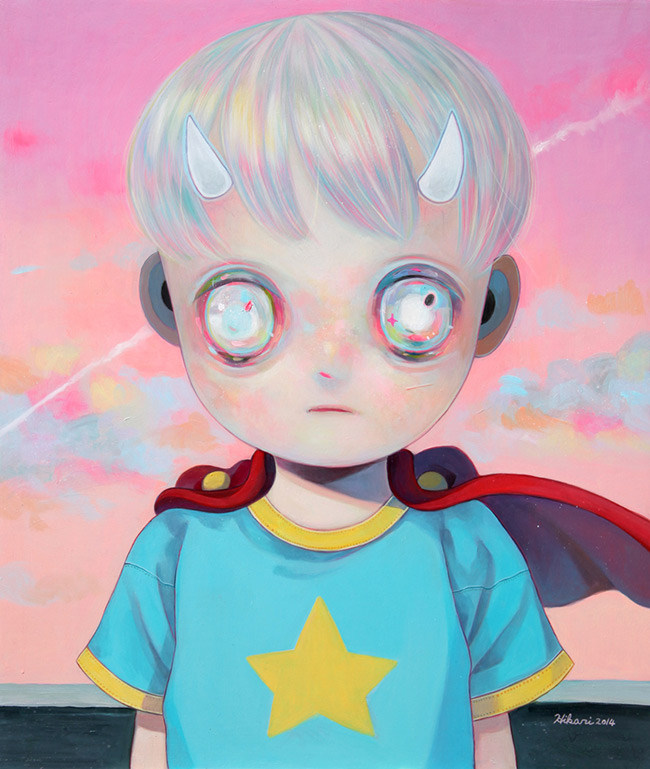
Concepts revolving around duality exist in your work, where you regularly explore themes of hope and despair; life and death; light and dark; reality and fantasy. What fascinates you the most about these opposing threads and what sort of balance do you aim to achieve between them?
It’s not my intention to create a specific image. In every day life, people are layered and have many sides, whether good or bad, even in a peaceful country like Japan. However, when the Great East Japan earthquake occurred, the peaceful every day collapsed in an instant, and nuclear power, which had been commercialized as ‘natural and safe’, suddenly became a threat. Immediately, I felt the need to express a feeling of discomfort with the ‘peaceful’ life, and in doing so, bring to mind serious issues that we were not previously aware of, or could not see. I choose to express this with positive visuals that don’t appear serious on the surface, but the essence of my work is more earnest and grave.
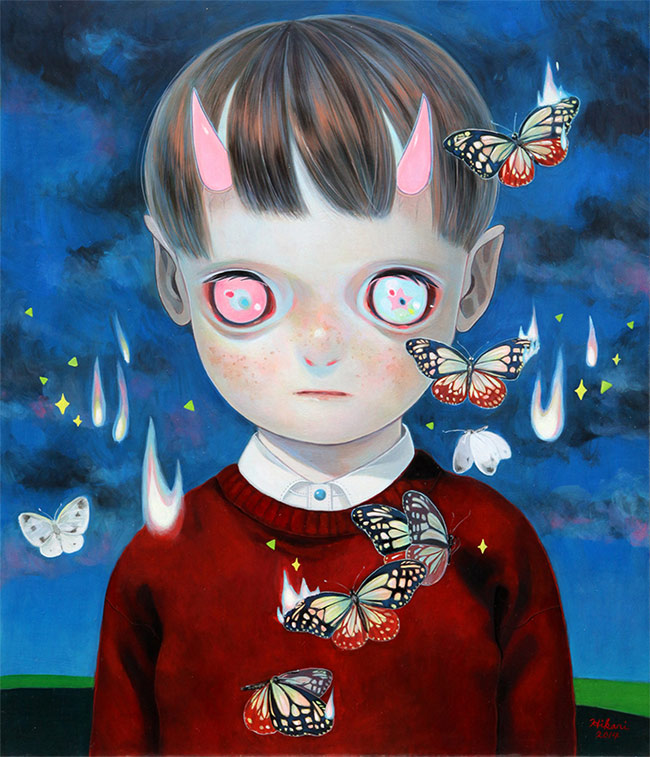
Although your characters are dealing with issues of a human nature, they, or their environments, often display elements that appear to point towards the supernatural. Please talk to us about this aspect of your work and what these magical references mean to you and the narratives you create.
The element of ‘magic’ in my work is used as a metaphor. I often present this idea of mankind creating a ‘savior’ for the world, sometimes appearing like a ‘magical girl’, but in order to save the world, she must destroy mankind. This is a direct reflection of the way we self-annihilate; we kill each other with powerful weapons, or destroy this delicate planet which gives us life. But I do not want to dwell on the on misery or the meaninglessness of war; my focus is what this means for our future. So, the magic that appears in my art symbolizes the irony in this cycle of mankind’s actions causing his own demise.
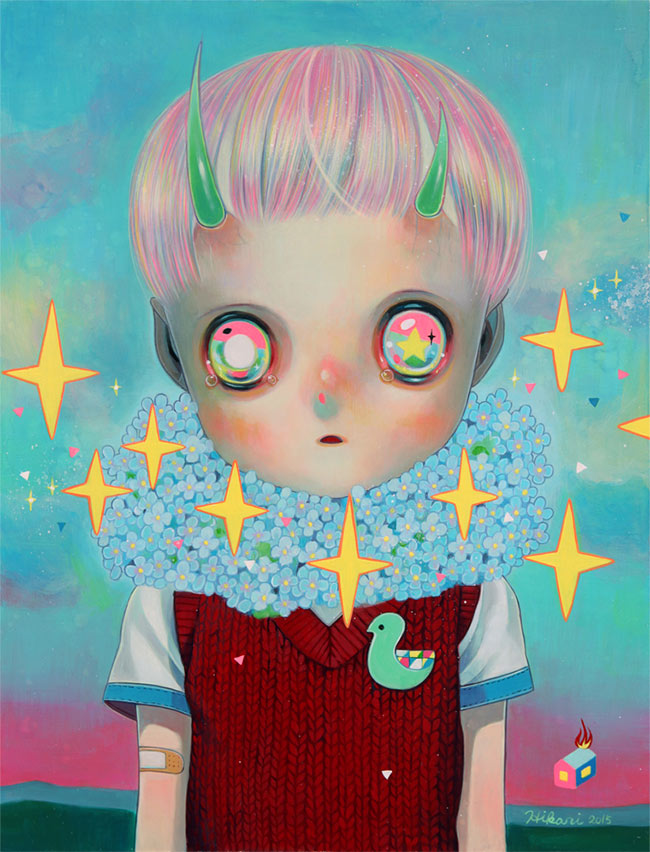
The pop culture influenced aesthetic of your imagery provides an enticing invitation to explore the content of your work, which we know contains a wealth of personal and emotional material inspired by real life tragedies and traumas. What sort of criteria must the pop culture inclusions meet in order to aid you with the creation of your narratives?
Many people are now familiar with kawaii or Japanese ‘cute’. I am interested in cuteness as an artistic tool. I deal with very serious and negative themes in my work. It takes a lot of bravery to face what scares us, or disgusts us, whatever is causing negativity in our lives. I’m not interested in creating imagery that appears extremely negative, which could come off as abrupt and unattractive. Characters and images from pop culture offer a sense of familiarity and ease; I thought that this could make my art easier for the viewer to accept, and I can deliver my vision to both adults and children alike around the world. Pop culture in Japan has many bright hues and positive motifs, so I came to incorporate it into my work.
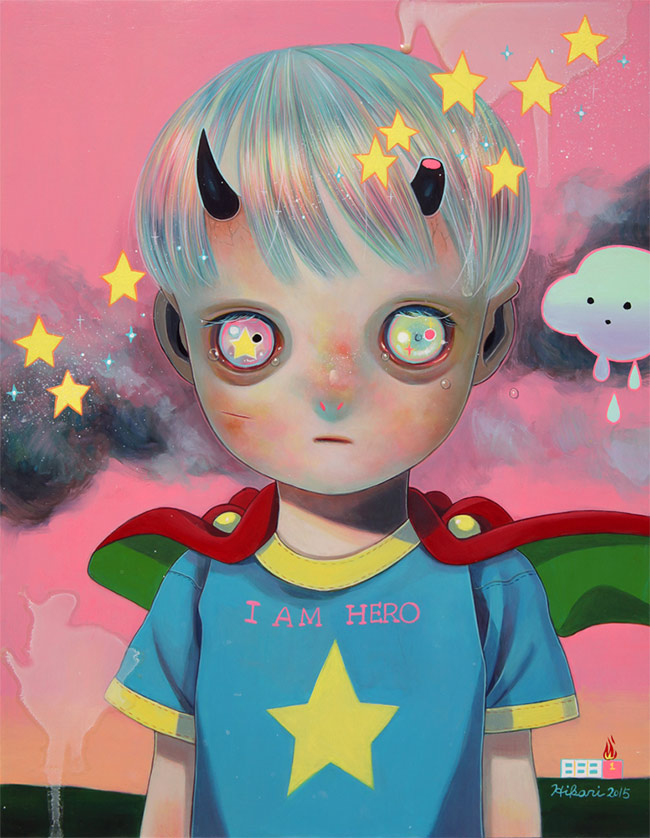
You have previously stated that philosophy has an influence on your work. We’d love to hear more about particular philosophers whose thoughts inspire you and how these ideas manifest themselves in your imagery.
Recently, I’ve been referring to the German critic and philosopher Walter Benjamin, who I feel precisely described the future of mankind. According to Scholem, Benjamin felt a mystical identification with Paul Klee’s work ‘Angelus Novus’, and incorporated it in his own theory of the ‘angel of history’, a melancholy view of historical process as an unceasing cycle of despair. I painted my interpretation of this in my 2016 painting of the same name, ‘Angel of History’.
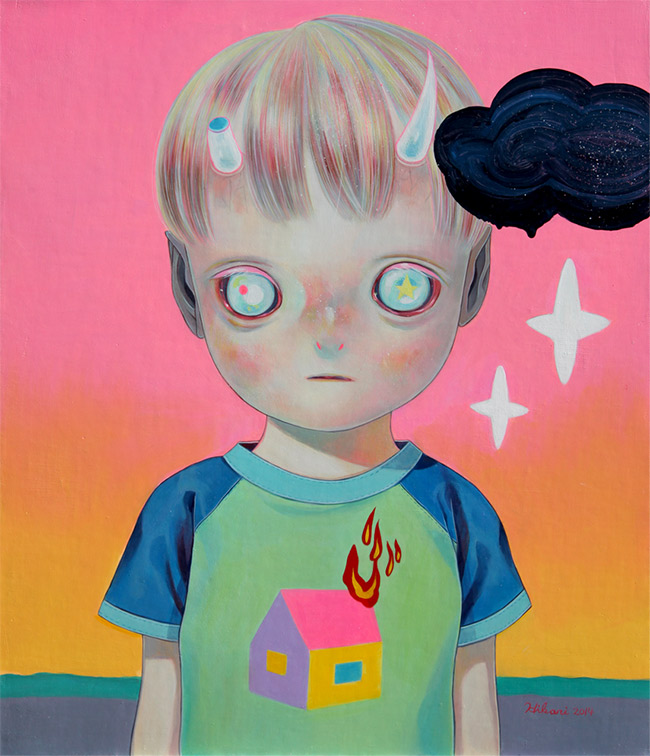
What has been the toughest challenge you’ve faced in your career so far and what steps did you take or are you taking to overcome those difficulties you’ve experienced?
As I mentioned earlier, I have always tried to convey a universal language in my work, and I think this has been my greatest challenge. This is something I could only realize by creating work and watching the viewer’s reaction to it, then going back to incorporate new visuals, like bold colors and anime motifs, presenting new work, and so on; it has been an ongoing conversation to get my theme across. The Great East Japan earthquake also affected me greatly, and this has been a big influence of my narrative over time.
I feel that I’ve come into my own and my recent work is at its strongest in theme and style. There has been increasing interest from people overseas, and this has helped me to secure new venues to share my art, and better sales, and so on. So, there are a lot of steps to overcoming career challenges.
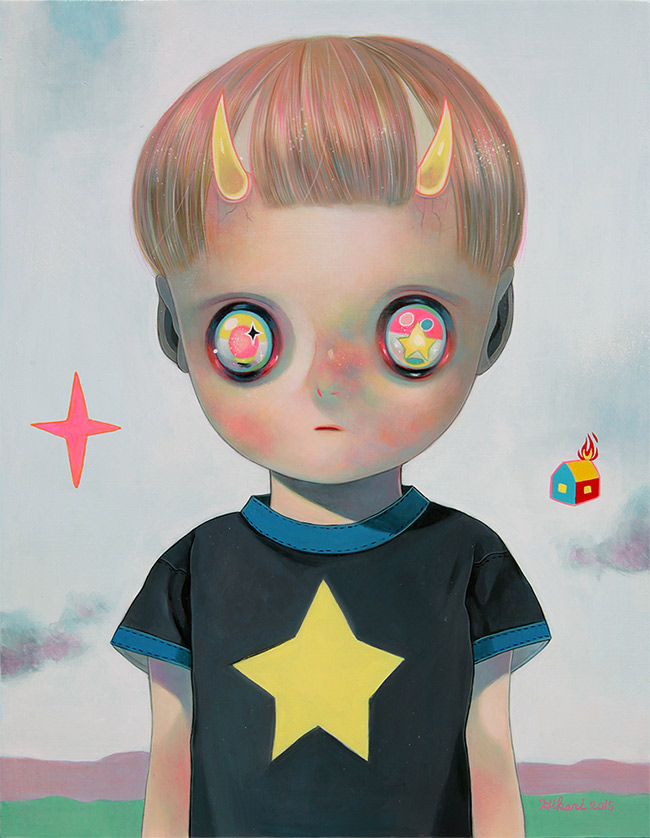
To what extent do you consider your audience while creating your art?
I consider the audience in the sense that I want my characters to convey feelings of all people, and I hope that comes across in the final image.
In order to get a better understanding of the personality of an artist, it can help to get a peek behind the curtain. Would you be willing to share a story from your own life, one which you feel has contributed to shaping the person and therefore the artist you are today?
Although I had a lot of friends and enjoyed drawing as a child, I sought praise from my parents and when I didn’t get it, I developed a sense of feeling inferior. For me, to be an artist, you need to have a lot of passion, and a bit of an obsessive personality, to go down this path and listen to your own ideas. This is why I became a professional artist, rather than an illustrator working for hire. I want to use the expressive means of painting to project my own thoughts as the creator onto each piece.
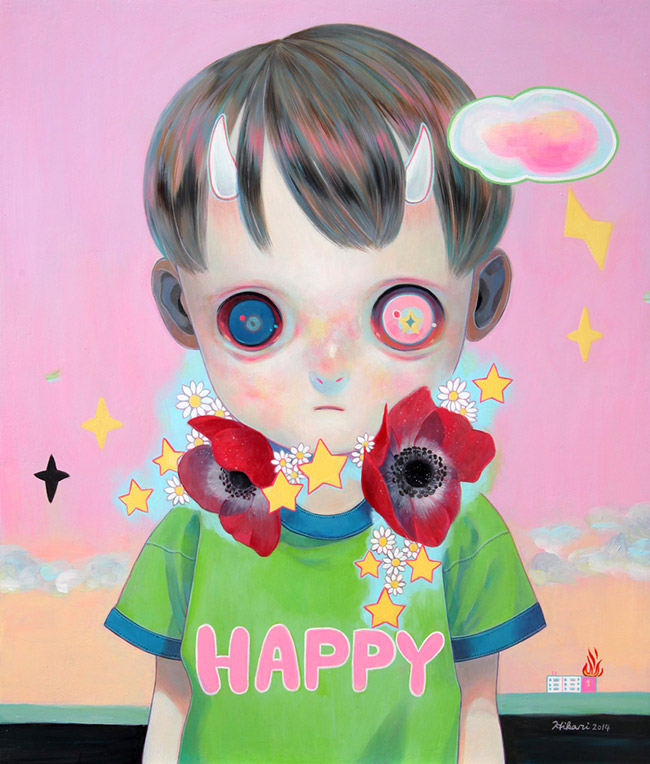
If you could own one piece of art from any of the world’s collections, what piece would you choose and why?
I would want a work by Loretta Lux. Her child subjects appear so ethereal and beautiful, and I could stare at them forever. I’m influenced by the charm and creativity of her figures, and like the idea of summarizing our human complexity into an image that is simple with minimal detail.
What’s next for Hikari Shimoda?
Up next, I will be in a 2-person exhibition with Michael Page, opening January 21st at Corey Helford Gallery in Los Angeles. As for what the future holds, I believe that you must always try to capture what’s in your heart to make great work, so that’s what I want to do.
